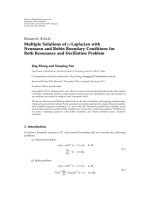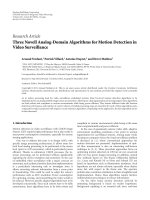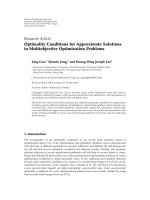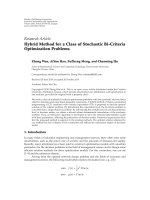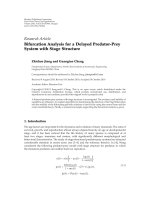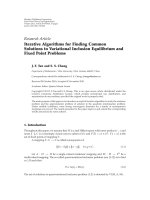Báo cáo hóa học: " Research Article Three Solutions for a Discrete Nonlinear Neumann Problem Involving the p-Laplacian Pasquale Candito1 and Giuseppina D’Agu`2 ı" pptx
Bạn đang xem bản rút gọn của tài liệu. Xem và tải ngay bản đầy đủ của tài liệu tại đây (513.61 KB, 11 trang )
Hindawi Publishing Corporation
Advances in Difference Equations
Volume 2010, Article ID 862016, 11 pages
doi:10.1155/2010/862016
Research Article
Three Solutions for a Discrete Nonlinear Neumann
Problem Involving the p-Laplacian
Pasquale Candito
1
and Giuseppina D’Agu`ı
2
1
DIMET University of Reggio Calabria, Via Graziella (Feo Di Vito), 89100 Reggio Calabria, Italy
2
Department of Mathematics of Messina, DIMET University of Reggio Calabria,
89100 Reggio Calabria, Italy
Correspondence should be addressed to Giuseppina D’Agu
`
ı,
Received 26 October 2010; Accepted 20 December 2010
Academic Editor: E. Thandapani
Copyright q 2010 P. Candito and G. D’Agu
`
ı. This is an open access article distributed under
the Creative Commons Attribution License, which permits unrestricted use, distribution, and
reproduction in any medium, provided the original work is properly cited.
We investigate the existence of at least three solutions for a discrete nonlinear Neumann boundary
value problem involving the p-Laplacian. Our approach is based on three critical points theorems.
1. Introduction
In these last years, the study of discrete problems subject to various boundary value con-
ditions has been widely approached by using different abstract methods as fixed point
theorems, lower and upper solutions, a nd Brower degree see, e.g., 1–3 and the reference
given therein. Recently, also the critical point theory has aroused the attention of many
authors in the study of these problems 4–12.
The main aim of this paper is to investigate different sets of assumptions which
guarantee the existence and multiplicity of solutions for the following nonlinear Neumann
boundary value problem
−Δ
φ
p
Δu
k−1
q
k
φ
p
u
k
λf
k, u
k
,k∈
1,N
,
Δu
0
Δu
N
0,
P
f
λ
where N is a fixed positive integer, 1,N is the discrete interval {1, ,N}, q
k
> 0forall
k ∈ 1,N, λ is a positive real parameter, Δu
k
: u
k1
− u
k
, k 0, 1, ,N 1, is the forward
difference operator, φ
p
s : |s|
p−2
s,1<p<∞,andf : 1,N × → is a continuous
function.
2AdvancesinDifference Equations
In particular, for every λ lying in a suitable interval of parameters, at least three
solutions are obtained under mutually independent conditions. First, we require that the
primitive F of f is p-sublinear at infinity and satisfies appropriate local growth condition
Theorem 3.1. Next, we obtain at least three positive solutions uniformly bounded with
respect to λ, under a suitable sign hypothesis on f, an appropriate growth conditions on F in a
bounded interval, and without assuming asymptotic condition at infinity on f Theorem 3.4,
Corollary 3.6. Moreover, the existence of at least two nontrivial solutions for problem P
f
λ
is
obtained assuming that F is p-sublinear at zero and p-superlinear at infinity Theorem 3.5.
It is worth noticing that it is the first time that this type of results are obtained for
discrete problem with Neumann boundary conditions; instead of Dirichlet problem, similar
results have been already given in 6, 9, 13.Moreover,in14, the existence of multiple
solutions to problem P
f
λ
is obtained assuming different hypotheses with respect to our
assumptions see Remark 3.7.
Investigation on the relation between continuous and discrete problems are available
in the papers 15, 16. General references on difference equations and their applications in
different fields of research are given in 17, 18. While for an overview on variational methods,
we refer the reader to the comprehensive monograph 19.
2. Critical Point Theorems and Variational Framework
Let X be a real Banach space, let Φ, Ψ : X → be two functions of class C
1
on X,andletλ
be a positive real parameter. In order to study problem P
f
λ
, our main tools are critical points
theorems for functional of type Φ −λΨ which insure the existence at least three critical points
for every λ belonging to well-defined open intervals. These theorems have been obtained,
respectively, in 6, 20, 21.
Theorem 2.1 see 11, Theorem 2.6. Let X be a reflexive real Banach space, Φ : X →
be a
coercive, continuously G
ˆ
ateaux differentiable and sequentially weakly lower semicontinuous func-
tional whose G
ˆ
ateaux derivative admits a continuous inverse on X
∗
, Ψ : X → be a continuously
G
ˆ
ateaux differentiable functional whose G
ˆ
ateaux derivative is compact such that
Φ
0
Ψ
0
0. 2.1
Assume that there exist r>0 and v ∈ X,withr<Φv such that
a
1
sup
Φu≤r
Ψu/r < Ψv/Φv,
a
2
for each λ ∈ Λ
r
:Φv/Ψv,r/sup
Φu≤r
Ψu the functional Φ − λΨ is coercive.
Then, for each λ ∈ Λ
r
, t he functional Φ − λΨ has at least three distinct critical points in X.
Theorem 2.2 see 7, Corollary 3.1. Let X be a reflexive real Banach space, Φ : X →
be a
convex, coercive, and continuously G
ˆ
ateaux differentiable functional whose G
ˆ
ateaux derivative admits
a continuous inverse on X
∗
,andletΨ : X → be a continuously G
ˆ
ateaux differentiable functional
whose G
ˆ
ateaux derivative is compact such that
inf
X
ΦΦ
0
Ψ
0
0. 2.2
Advances in Difference Equations 3
Assume that there exist two positive constants r
1
, r
2
and v ∈ X,with2r
1
< Φv <r
2
/2 such that
b
1
sup
Φu≤r
1
Ψu/r
1
< 2/3Ψv/Φv,
b
2
sup
Φu≤r
2
Ψu/r
2
< 1/3Ψv/Φv,
b
3
for each λ ∈ Λ
:3/2Φv/Ψv, min{r
1
/sup
Φu≤r
1
Ψv,r
2
/2sup
Φu≤r
2
Ψu}
and for every u
1
,u
2
∈ X, which are local minima for the functional Φ − λΨ such that
Ψu
1
≥ 0 and Ψu
2
≥ 0, and one has inf
t∈0,1
Ψtu
1
1 − tu
2
≥ 0.
Then, for each λ ∈ Λ
, the functional Φ − λΨ admits at least three critical points which lie in
Φ
−1
−∞,r
2
.
Finally, for all r>inf
X
Φ,weput
ϕ
r
inf
u∈Φ
−1
−∞,r
sup
u∈Φ
−1
−∞,r
Ψ
u
− Ψ
u
r − Φ
u
,
λ
∗
:
1
inf
{r>inf
X
Φ}
ϕ
r
,
2.3
where we read 1/0:∞ if this case occurs.
Theorem 2.3 see 8, Theorem 2.3. Let X be a finite dimensional real Banach space. Assume that
for each λ ∈0,λ
∗
one has
e lim
u→∞
Φ − λΨ−∞.
Then, for each λ ∈0,λ
∗
, the functional Φ − λΨ admits at least three distinct critical points.
Remark 2.4. It is worth noticing that whenever X is a finite dimensional Banach space,
a careful reading of the proofs of Theorems 2.1 and 2.2 shows that regarding to the regularity
of the derivative of Φ and Ψ, it is enough to require only that Φ
and Ψ
are two continuous
functionals on X
∗
.
Now, consider the N-dimensional normed space W {u : 0,N 1 →
: Δu
0
Δu
N
0} endowed with the norm
u
:
N1
k1
|
Δu
k−1
|
p
N
k1
q
k
|
u
k
|
p
1/p
, ∀u ∈ W. 2.4
In the sequel, we will use the following inequality:
max
k∈0,N1
|
u
k
|
≤
u
q
1/p
, ∀u ∈ W wher e q : min
k∈1,N
q
k
. 2.5
Moreover, put
Φ
u
:
u
p
p
, Ψ
u
:
N
k1
F
k, u
k
, ∀u ∈ W, 2.6
4AdvancesinDifference Equations
where Fk, t :
t
0
fk,ξdξ for every k, t ∈ 1,N × . It is easy to show that Φ and Ψ are
two C
1
-functionals on W.
Next lemma describes the variational structure of problem P
f
λ
,forthereader
convenience we give a sketch of the proof, see also 14,
Lemma 2.5. W, · is a Banach space. Let u ∈ W, u be a solution of problem P
f
λ
if and only if u
is a critical point of the functional Φ − λΨ.
Proof. Bearing in mind both that a finite dimensional normed space is a Banach space and
the following partial sum:
−
N
k1
Δ
φ
p
Δu
k−1
v
k
N1
k1
φ
p
Δu
k−1
Δv
k−1
, 2.7
for every u and v ∈ W, standard variational arguments complete the proof.
Finally, we point out the following strong maximum principle for problem P
f
λ
.
Lemma 2.6. Fix u ∈ W such that
−Δ
φ
p
Δu
k−1
q
k
|
u
k
|
p−2
u
k
≥ 0 ∀k ∈
1,N
. 2.8
Then, either u>0 in 1 ,N,oru ≡ 0.
Proof. Let j ∈ 1,N be such that u
j
min
k∈1,N
u
k
. An immediate computation gives
Δu
j
≥ 0, Δu
j−1
≤ 0. 2.9
From this, by 2.8,weobtain
q
j
u
j
p−2
u
j
≥
Δu
j
p−2
Δu
j
−
Δu
j−1
p−2
Δu
j−1
≥ 0, 2.10
so u
j
≥ 0, that is u ≥ 0. Moreover, assuming that u
j
0, from the preciding inequality and
nonnegativity of u
j−1
,u
j1
, one has
0 ≤
Δu
j
p−2
u
j1
Δu
j−1
p−2
u
j−1
≤ 0, 2.11
so u
j−1
u
j1
0. Thus, repeating these arguments, the conclusion follows at once.
3. Main Results
For each positive constants c and d,wewrite
A
c
:
N
k1
max
|t|≤c
F
k, t
c
p
,B
d
:
N
k1
F
k, d
d
p
,Q:
N
k1
q
k
. 3.1
Advances in Difference Equations 5
Now, we give the main results.
Theorem 3.1. Assume that there exist three positive constants c, d,ands with c<d,ands<psuch
that
i
1
Ac < q/QBd,
i
2
max
k∈1,N
lim sup
|t|→∞
Fk, t/|t|
s
< ∞.
Then, for every
λ ∈
Q
p
1
B
d
,
q
p
1
A
c
, 3.2
problem P
f
λ
admits at least t hree solutions.
Proof. We apply Theorem 2.1, by putting Φ and Ψ defined as in 2.6 on the space W.An
easy computation ensures the regularity assumptions required on Φ and Ψ;seeRemark 2.4.
Therefore, it remains to verify assumptions a
1
and a
2
.Tothishand,weput
r
q
p
c
p
, 3.3
and we pick v ∈ W, defined by putting
v
k
d for every k ∈
1,N
. 3.4
Clearly, since c<d, one has r<ΦvQ/pd
p
,andinaddition,by2.5,wehave
sup
u∈Φ
−1
−∞,r
Ψ
u
r
≤
sup
u
∞
≤c
Ψ
q/p
c
p
≤
p
q
A
c
. 3.5
On the other hand, we compute
Ψ
v
Φ
v
p
Q
B
d
. 3.6
Therefore, by i
1
, combining 3.5 and 3.6, it is clear that a
1
holds. Moreover, one has
Q
p
1
B
d
,
q
p
1
A
c
⊂ Λ
r
. 3.7
Now, fix λ as in the conclusion; first, we observe that for every 1 ≤ s ≤ p, one has
N
k1
|
u
k
|
s
≤ Nq
−s/p
u
s
, ∀u ∈ W. 3.8
6AdvancesinDifference Equations
Next, by i
2
, there exist two positive constants M
1
and M
2
such that
F
k, ξ
≤ M
1
|
ξ
|
s
M
2
, ∀
k, ξ
∈
1,N
× . 3.9
Hence, f or every u ∈ W,weget
Φ
u
− λΨ
u
≥
u
p
p
− λM
1
N
1
|
u
k
|
s
− λNM
2
≥
u
p
p
− λM
1
N
q
s/p
u
s
− λNM
2
.
3.10
At this point, since s<p, it is clear that the functional Φ − λΨ turns out to be coercive.
Remark 3.2. We note that hypothesis i
2
can be replaced with the following:
i
2
max
k∈1,N
lim sup
|t|→∞
Fk, t/|t|
p
<Ac/N.
Arguing as before, there exist two constant L
1
<Ac/N and L
2
such that
F
k, ξ
≤ L
1
|
ξ
|
p
L
2
, ∀
k, ξ
∈
1,N
× . 3.11
Hence, f or every u ∈ W, it easy to see that
Φ
u
− λΨ
u
≥
u
p
p
−
q
p
1
A
c
L
1
N
q
u
p
− λNL
2
≥
1
p
1 −
NL
1
A
c
u
p
− λNL
2
, 3.12
with 1 − NL
1
/Ac > 0.
Remark 3.3. It is worth noticing that a careful reading of the proof of Theorem 3.1 shows
that, provided that Ac0 and under the only condition i
2
,problemP
f
λ
admits at least
one solution for every λ>0 and at least three solutions for every λ ∈Q/p1/Bd, ∞,
whenever there exists d>0forwhichBd > 0.
Theorem 3.4. Let f be a continuous function in 1,N × 0, ∞ such that fk,0
/
0 for some
k ∈ 1,N. Assume that there exist three positive constants c
1
, d,andc
2
with 2q/Q
1/p
c
1
<d<
1/2q/Q
1/p
c
2
such that
j
1
fk,ξ ≥ 0 for each k, ξ ∈ 1,N × 0,c
2
,
j
2
max{Bc
1
, 2Bc
2
} < 2/3q/QBd.
Then, for each λ ∈3/2Q/p1/Bd, q/p min{1/Bc
1
, 1/2Bc
2
},problemP
f
λ
admits at
least three positive solutions u
i
, i 1, 2, 3,suchthat
u
i
k
<c
2
, 3.13
for all k ∈ 1,N, i 1, 2, 3.
Advances in Difference Equations 7
Proof. Consider the auxiliary problem
−Δ
φ
p
Δu
k−1
q
k
φ
p
u
k
λ
f
k, u
k
,k∈
1,N
,
Δu
0
Δu
N
0,
P
f
λ
where
f : 1,N ×
→ is a continuous function defined putting
f
k, ξ
⎧
⎪
⎪
⎪
⎨
⎪
⎪
⎪
⎩
f
k, 0
, if ξ<0,
f
k, ξ
, if 0 ≤ ξ ≤ c
2
,
f
k, c
2
, if ξ>c
2
.
3.14
From j
1
,owingtoLemma 2.6, any solution of problem P
f
λ
is positive. In addition, if
it satisfies also the condition 0 ≤ u
k
≤ c
2
,andforeveryk ∈ 1,N, clearly it turns
to be also a positive solution of P
f
λ
. Therefore, f or our goal, it is enough to show that
our conclusion holds for P
f
λ
. In this connection, our aim is to apply Theorem 2.2. Fix
λ in 3/2Q/p1/Bd, q/p min{1/Bc
1
, 1/2Bc
2
} and let Φ, Ψ and W as before.
Now, take
r
1
q
p
c
p
1
,r
2
q
p
c
p
2
. 3.15
From 2.5, arguing as before, we obtain
max
k∈1,T
|
u
k
|
≤ c
1
, 3.16
for all u ∈ W such that u≤pr
1
1/p
,and
max
k∈1,T
|
u
k
|
≤ c
2
, 3.17
for all u ∈ W such that u≤pr
2
1/p
.
Therefore, one has
sup
u∈Φ
−1
−∞,r
1
Ψ
u
r
1
sup
u<pr
1
1/p
N
k1
F
k, u
k
r
1
≤
N
k1
F
k, c
1
r
1
p
q
B
c
1
, 3.18
as well as
sup
u∈Φ
−1
−∞,r
2
Ψ
u
r
2
≤
p
q
B
c
2
. 3.19
8AdvancesinDifference Equations
On the other hand, pick v ∈ W,definedasin3.4, bearing in mind 3.6,andfrom
2q/Q
1/p
c
1
<d<1/2q/Q
1/p
c
2
,weobtain2r
1
< Φv <c
2
/2 Moreover, taking into
account 3.18, 3.19,fromj
1
, assumptions b
1
and b
2
follow. Further, again from 3.18,
3.19,and3.6, one has that
λ ∈
3
2
Q
p
1
B
d
,
q
p
min
1
B
c
1
,
1
2B
c
2
⊂ Λ
. 3.20
Now, let u
1
and u
2
be two local minima for Φ −λΨ such that Ψu
1
≥ 0andΨu
2
≥ 0. Owing
to Lemmas 2.5 and 2.6, they are two positive solutions for P
f
λ
so tu
1
k
1 − tu
2
k
≥ 0, for all
k ∈ 1,N and for all t ∈ 0, 1. Hence, since one has Ψtu
1
1 − tu
2
≥ 0forallt ∈ 0, 1,
b
3
is verified.
Therefore, the functional Φ −λΨ admits at least three critical points u
i
, i 1, 2, 3, which
are three positive solutions of P
f
λ
. Finally, from 2.5,fori 1, 2, 3, one has
max
k∈1,N
u
i
k
≤ c
2
, 3.21
and the proof is completed.
Theorem 3.5. Let f : 1,N × → be a continuous function such that fk, 0
/
0 for some
k ∈ 1,N. Assume that there exist four constants M
1
, M
2
, s,andα,withM
1
> 0, s>pand
0 ≤ α<ssuch that
l Fk, ξ ≥ M
1
|ξ|
s
− M
2
|ξ|
α
, for all k, ξ ∈ 1 ,N × .
Then, for each λ ∈0,λ
∗
,where
λ
∗
:
q
p
1
sup
c>0
A
c
, 3.22
problem P
f
λ
admits at least t hree nontrivial solutions.
Proof. Our aim is to apply Theorem 2.3 with Φ and Ψ as above. Fix λ ∈0,
λ,andthereisc>0
such that λ<q/p1/Ac. Setting r q/pc
p
and arguing as in the proof of Theorem 3.1,
one has
1
λ
∗
≤ ϕ
r
≤
sup
u∈Φ
−1
−∞,r
Ψ
u
r
≤
p
q
A
c
<
1
λ
, 3.23
that is λ<λ
∗
.Moreover,denote
q max
k∈1,N
q
k
, 3.24
Advances in Difference Equations 9
it is a simple matter to show that for each u ∈ W, one has
N
k1
|
u
k
|
s
≥
u
s
N 1
2
p
q
s/p
N
s−p/p
,
N
k1
|
u
k
|
α
≤ Nq
−α/p
u
α
. 3.25
Hence, from l,foreachu ∈ W,weget
Φ
u
− λΨ
u
≤
u
p
p
−
λM
1
N 1
2
p
q
s/p
N
s−p/p
u
s
λM
2
Nq
−α/p
u
α
. 3.26
Therefore, since s>pand s>α, condition e is verified. Hence, from Theorem 2.3,the
functional Φ − λΨ admits three critical points, which are three solutions for P
f
λ
.Since
fk, 0
/
0forsomek ∈ 1,N, they are nontrivial solutions, and the conclusion is proved.
Corollary 3.6. Let f : 1,N × → be a continuous function such that fk, 0
/
0 for some
k ∈ 1,N. Assume that there exist four constants M
1
, M
2
, c,andα with M
1
> 0 and 0 ≤ α<p
such that
l
1
Ac <qM
1
/N 12
p
q,
l
2
Fk, ξ ≥ M
1
|ξ|
p
− M
2
|ξ|
α
, for all k, ξ ∈ 1 ,N × .
Then, for every
λ ∈
N 1
2
p
q
pM
1
,
q
p
1
A
c
, 3.27
problem P
f
λ
admits at least t hree solutions.
Proof. Our claim is to prove that condition e of Theorem 2.3 holds for every λ ∈N12
p
q/pM
1
, q/p1/Ac⊂0,λ
∗
.Indeed,froml
1
,arguingasin3.23, one has that λ<λ
∗
.
Moreover, by l
2
,from3.26 with s p, for every u ∈ W,wehave
Φ
u
− λΨ
u
≤
u
p
p
−
λM
1
N 1
2
p
q
u
p
λM
2
Nq
−α/p
u
α
≤
1
p
−
λM
1
N 1
2
p
q
u
p
λM
2
Nq
−α/p
u
α
,
3.28
where 1/p − λM
1
/N 12
p
q < 0, which implies condition e.
Remark 3.7. In 14, by Mountain Pass Theorem, the authors established the existence of at
least one solution for problem P
f
λ
requiring the following conditions:
θ
1
fk, t◦|t|
p−1
for t → 0 uniformly in k ∈ 1,N,
10 Advances in Difference Equations
θ
2
there exist two positive constants ρ and s with s>psuch that
0 <sF
k, t
≤ tf
k, t
, 3.29
for every |t| >ρand k, ξ ∈ 1,N ×
.
Moreover, they remember that the above conditions imply, respectively, the following:
θ
3
Fk, t◦|t|
p
for t → 0 uniformly in k ∈ 1,N,
θ
4
there exist two positive constants M
1
and M
2
such that
F
k, ξ
≥ M
1
|
ξ
|
s
− M
2
, ∀
k, ξ
∈
1,N
× . 3.30
Next result shows that under more general conditions than θ
3
and θ
4
,problemP
f
1
has at least two nontrivial solutions.
Theorem 3.8. Assume that (l
2
) holds and in addition
θ
5
max
k∈1,N
lim sup
|t|→0
Fk, t/|t|
p
< ∞.
Then, problem (P
f
1
) has at least two nontrivial solutions.
Proof. We claim that the functional Φ −Ψ admits a local minimum at zero and a local nonzero
maximum. To this end, we observe that by θ
5
,thereexistM>0andρ>0suchthat
F
k, t
≤ M
1
|
t
|
p
, for every
|
t
|
≤ ρ, k ∈
1,N
. 3.31
Hence, bearing in mind Lemma 2.5 and 3.25,withs p, for every u ∈ W with u≤ρ
p
√
q,
we get
Φ
u
− Ψ
u
≥
1
p
−
MN
q
u
p
p
≥ 0 Φ
0
− Ψ
0
, 3.32
that is, 0 is a local minimum. Moreover, by l
2
, by now, it is evident that the functional
Φ − Ψ is anticoercive in W. Hence, by the regularity of Φ − Ψ,thereexists
u ∈ W which is a
global maximum for the functional. Therefore, since it is not restrictive to suppose that
u
/
0
otherwise, there are infinitely many critical points, our conclusion follows: if dimX ≥ 2,
from Corollary 2.11 of 22 which ensures a third critical point different from 0 and
u and by
standards arguments if dimX1.
References
1 D. R. Anderson, I. Rach
˚
unkov
´
a, and C. C. Tisdell, “Solvability of discrete Neumann boundary value
probles,” Advances in Differential Equations, vol. 2, pp. 93–99, 2007.
2 C. Bereanu and J. Mawhin, “Boundary value problems for second-order nonlinear difference
equations with discrete φ-Laplacian and singular φ,” Journal of Difference Equations and Applications,
vol. 14, no. 10-11, pp. 1099–1118, 2008.
Advances in Difference Equations 11
3 I. Rach
˚
unkov
´
a and C. C. Tisdell, “Existence of non-spurious solutions to discrete Dirichlet problems
with lower and upper solutions,” Nonlinear Analysis: Theory, Methods & Applications, vol. 67, no. 4, pp.
1236–1245, 2007.
4 R. P. Agarwal, K. Perera, and D. O’Regan, “Multiple positive solutions of singular and nonsingular
discrete problems via variational methods,” Nonlinear Analysis: Theory, Methods & Applications,vol.
58, no. 1-2, pp. 69–73, 2004.
5 R. P. Agarwal, K. Perera, and D. O’Regan, “Multiple positive solutions of singular discrete p-Laplacian
problems via variational methods,” Advances in Difference Equations, no. 2, pp. 93–99, 2005.
6 G. Bonanno and P. Candito, “Nonlinear difference equations investigated via critical point methods,”
Nonlinear Analysis: Theory, Methods & Applications, vol. 70, no. 9, pp. 3180–3186, 2009.
7 G. Bonanno and P. Candito, “Infinitely many solutions for a class of discrete non-linear boundary
value problems,” Applicable Analysis, vol. 88, no. 4, pp. 605–616, 2009.
8 G. Bonanno and P. Candito, “Difference equations through variational methods,” in Handbook on
Nonconvex Analysis, D. Y. Gao and D. Motreanu, Eds., pp. 1–44, International Press of Boston,
Sommerville, Boston, USA, 2010.
9 P. Candito and G. D’Agu
`
ı, “Three solutions to a perturbed nonlinear discrete Dirichlet problem,”
Journal of Mathematical Analysis and Applications, vol. 375, no. 2, pp. 594–601, 2011.
10 P. Candito and G. Molica Bisci, “Existence of two solutions for a nonlinear second-order discrete
boundary value problem,” to appear in Advanced Nonlinear Studies.
11 L. Jiang and Z. Zhou, “Three solutions to Dirichlet boundary value problems for p-Laplacian
difference equations,” Advances in Difference Equations, vol. 2008, Article ID 345916, 10 pages, 2008.
12 A. Krist
´
ely, M. Mihailescu, and V. Radulescu, “Discrete boundary value problems involving
oscillatory nonlinearities: small and large solutions,” Journal of Difference Equations and Applications.
In press.
13 P. Candito and N. Giovannelli, “Multiple solutions for a discrete boundary value problem involving
the p-Laplacian,” Computers & Mathematics with Applications, vol. 56, no. 4, pp. 959–964, 2008.
14 Y. Tian and W. Ge, “The existence of solutions for a second-order discrete Neumann problem with a
p-Laplacian,” Journal of Applied Mathematics and Computing, vol. 26, no. 1-2, pp. 333–340, 2008.
15 R. P. Agarwal, “On multipoint boundary value problems for discrete equations,” Journal of
Mathematical Analysis and Applications, vol. 96, no. 2, pp. 520–534, 1983.
16 L. Lov
´
asz, “Discrete and continuous: two sides of the same?” Geometric and Functional Analysis, pp.
359–382, 2000.
17 R. P. Agarwal, Difference Equations and Inequalities: Theory, Methods and Applications, vol. 228 of
Monographs and Textbooks in Pure and Applied Mathematics, Marcel Dekker, New York, NY, USA, 2nd
edition, 2000.
18 W. G. Kelley and A. C. Peterson, Differ ence Equations: An Introduction with Applications,Academic
Press, Boston, Mass, USA, 1991.
19 M. Struwe, Variational Methods,vol.34ofResults in Mathematics and Related Areas (3), Springer, Berlin,
Germany, 2nd edition, 1996.
20 G. Bonanno and S. A. Marano, “On the structure of the critical set of non-differentiable functions with
a weak compactness condition,” Applicable Analysis, vol. 89, no. 1, pp. 1–10, 2010.
21 G. Bonanno and P. Candito, “Non-differentiable functionals and applications to elliptic problems with
discontinuous nonlinearities,” Journal of Differential Equations, vol. 244, no. 12, pp. 3031–3059, 2008.
22 G. Fang, “On the existence and the classification of critical points for non-smooth functionals,”
Canadian Journal of Mathematics, vol. 47, no. 4, pp. 684–717, 1995.




